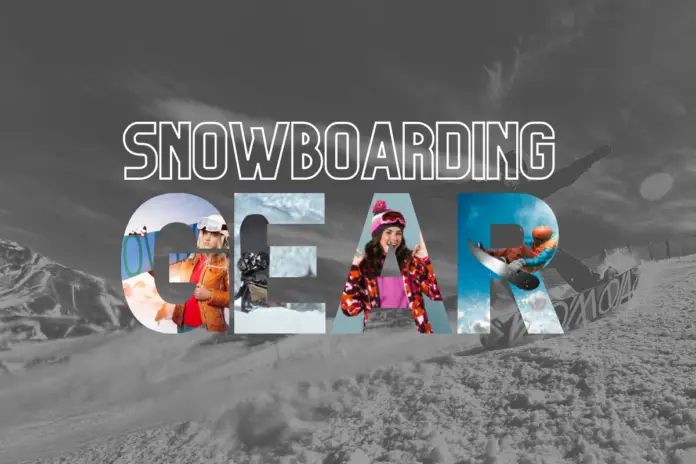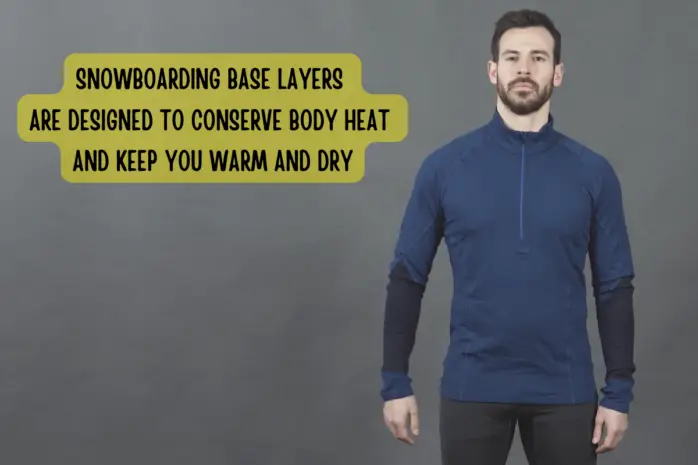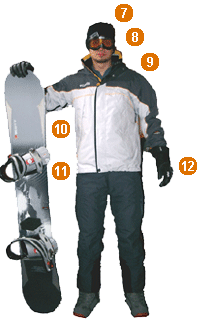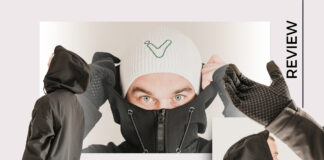
This section provides you with a list of the basic snowboard gear that you will need for this winter sport. Wearing the right apparel would enable you to perform various snowboarding styles and snowboard tricks better for a longer period of time.
Generally, the ideal way of clothing for any winter activity is to dress in layers. This is because dressing in layers allows you to adapt to sudden changes in temperature by shedding a layer, and prepares you for the times you will find yourself overheating from pushing your endurance to limits.
The keys to a successful layering system, in order of importance, are warmth, weight, moisture management and packing the right number of layers. For most winter sports, the three-layer system is applicable: the base or inner layer, the middle or second layer, and the outer layer.
The first layer is the base layer which consists of underwear and socks. Also known as the inner layer, this snowboarding clothing traps warmth against your body while ‘wicking’ moisture away from your skin.
The middle layer consists of general clothing or a fleece jacket. This layer provides extra insulation and transfers moisture toward the outer layer. On the other hand, the outer layer protects your body against wind and rain and expels excess moisture.
What follows are basic guidelines on what snowboarding clothes to wear and why you should wear them. For a quick link to the particular snowboarding item of your choice, click the links at the bottom of each type of snowboard gear:
I Base Layer
This is the first layer of clothing that comes next to the skin. Pieces of Snowboard Gear for the base layer are designed to conserve body heat and keep you warm and dry.
The best materials for the base layer are space-age-wicking materials that draw moisture away from the body as well as keep you warm. Synthetic materials like polypropylene are the most suitable for this purpose.
Although wool combinations also work well, they aren’t comfortable unless you have a high itch tolerance.
Keep in mind that the base layer should cover you from head to toe (i.e. comprising of a long-sleeved top, socks and full-length leggings or long johns). Also, stay away from cotton. Once cotton gets wet, its insulation capacities are lost, and thus it stays wet.
1. Thermal Body Shirt
Depending on the temperature (be sure to check this) you will want to use thermal or polypropylene underwear as the first level of clothing.
This Snowboarding Apparel will keep you warm and dry by wicking moisture away from the skin and transferring it to the next layer. When buying a thermal body shirt, be sure that it has long sleeves.
No products found.
2. Thermal Underwear
Thermal underwear is the best apparel to use as the first level of clothing. Polypropylene thermal underwear is readily available and does not scratch.
No products found.
3. Snowboarding Socks
The most important inner layer and the key to a good boot fit are socks. This Snowboard Gear is essential to keep your feet warm, dry, comfortable, and padded against hard impacts.
Choose thinner snowboard socks over thicker ones. Thin, synthetic socks are a good choice since soft boots already incorporate some insulation, and very thick socks encourage feet to sweat and lose warmth more quickly.
Preferably, buy special snowboarding socks that will give you more specialized features. Keep in mind that socks need to come at least halfway up the calf.
No products found.
<iframe width=”1237″ height=”696″ src=”https://www.youtube.com/embed/TT1YKe_xtU0″ title=”Best Base Layers for Skiing & Snowboarding” frameborder=”0″ allow=”accelerometer; autoplay; clipboard-write; encrypted-media; gyroscope; picture-in-picture” allowfullscreen></iframe>
II Second Layer
Also known as the second layer, the middle layer serves as the insulation layer. The Snowboarding Clothes for this layer are made of materials designed to trap warm air next to your body as you ride, and transfer moisture toward the outer layer.
Wool and fleece are the best materials to use here. Fleece is a great choice since it is lightweight and is able to ‘breathe’. Consequently, it acts as an effective channel for drawing moisture toward the outer layer of clothing.
You can put the middle layer on or off depending on the temperature and the amount of activity you perform. On warmer days the Snowboard Gear for this layer can serve as your outer layer of protection as well.
4. Fleece Jackets or Sweater
As a second layer, you will want a Fleece or a Wool sweater. The fleece is the key component to remaining warm since it is lightweight and is able to ‘breathe’.
Generally, though, it does not offer protection from the wind or rain. However, this Snowboard Gear has thermal properties that enable the body to breathe by allowing perspiration to evaporate through.
No products found.
5. Thermal Pants
Put on your Snowboarding Pants on top of your base layer. Snowboarding Pants are usually roomy. Still, make sure you don’t feel any pinching in the crotch area.
Otherwise, look for another pair. Moreover, a good pair of Snowboarding Pants should keep you warm and dry and should have basic padding on the knees and the rear that will prevent melting snow from seeping through.
No products found.
6. Snowboard Boots
These are special boots that will work together with your Snowboard Bindings to keep your body connected to your board. Snowboard Boots come in all regular shoe sizes.
However, different boots of the same size usually vary in the way they hold your feet and ankle. Quality boots can last for a long time so take the time to consider this when buying one.
No products found.
III Finishing the Basics
The outer layer serves as the barrier between you and the winter mountain environment. With all of your heat inside the inner two layers, the Snowboarding Clothing for the outer layer should allow moisture vapor out, and still maintain an effective barrier in keeping snow and water out.
It is also important that this layer has the ability to ‘breathe’ as it should allow heat from perspiration to escape from the inner layers of clothing. Thus, for your outer layer, wear windproof and waterproof apparel that is also breathable.
7. Beanie, Hat or Helmet
Do not expose your head and ears to extremely low temperatures, protect them with a comfortable hat or beanie.
If you prefer to wear a hat, choose one with little ear flaps. Remember, you can lose up to 90% of your body’s total heat through the top of your head. For head protection put on a Snowboard Helmet.
No products found.
8. Snowboarding Goggles
Protect your eyes from UV rays, snow, wind, ice, and tree branches with Snowboarding Goggles. This Snowboard Gear is designed for functionality (i.e. UV and full eye wind protection) and won’t fly off when you fall. Also, goggles can be placed over your hat and fastened onto your head.
No products found.
9. Snowboarding Jacket
Finish off your upper body layering with a water-repellant and windproof Snowboarding Jacket or top shell. Make sure that the fabric for this Snowboard Gear is also breathable.
Its ability to ‘breathe’ would allow heat from perspiration to escape from the inner layers of clothing.
No products found.
10. A Snowboard
The focal point of Snowboarding: The Snowboard. There are Three Different Types of Snowboards available on the market today: Freestyle, Freeride (All Mountain), and Alpine (Carving) Boards.
Each board has a unique Construction Technique and Materials, Shape, Flex Pattern, and Size. The type of board you ride should correspond to the Style of Riding that you like to do.
No products found.
11. Snowboard Bindings
Attach your boots to your Snowboard through sturdy Bindings. This Snowboard Gear typically comes in two or three sizes – Small, Medium and Large.
The size you choose will depend completely on the Snowboard Boot that you have chosen in combination with the binding.
Make sure the binding has the correct size that allows you to comfortably get into the binding and easily adjust the straps (when using strap binding) without leaving too much strap on either side.
No products found.
12. Snowboarding Gloves
Protect your hands from snow, ice and impacts with padded gloves – preferably those that are designed for snowboarding.
Choose gloves that are durable, waterproof, and have fleece or other synthetic-based insulated glove liners.
Also, make sure this Snowboard Gear has built-in reinforcements for the palm and the undersides of the fingers as they keep these areas from wearing through.
No products found.
One of the advantages of layers is that you can add and remove layers during the day according to the weather conditions and how you feel.
However, when buying your Snowboarding apparel, be sure that you manage the following problems: sweating, controlling of body temperature, protection from the elements, chafing and blisters.
Also, avoid clothes that are too large or too small, otherwise, the benefits of the latest fabric technology will be diluted.
For a more detailed discussion on most of the items enumerated in this section, browse over our Snowboarding Information.
To know the basic Snowboard Protective Gear that can help minimize your chances of sustaining an injury, at the same time attain a more pleasurable day on the slopes, go to our Snowboarding Protective Gear section.
How to Stay Warm While Snowboarding
When snowboarding, staying warm is essential. There are a few ways to do this.
One way to stay warm is to wear layers. Layer your clothing so that you have a base layer, an insulation layer, and a wind and waterproof layer. Make sure that the layers are fitted so that they move with you as you snowboard, and that they’re easy to get on and off.
Another way to stay warm is to use a thermal blanket. A thermal blanket transfers body heat quickly, so it can help keep you warm when the air temperature is below freezing.
Place the thermal blanket around your torso and legs, making sure that it’s securely fastened around your waist or hips.
If you’re feeling especially cold, consider wearing a ski jacket or coat over your clothes. Ski jackets and coats are made from materials like fleece, wool, or down that help trap body heat.
And don’t forget about hats! A good hat will keep your head warm, even when the air temperature is below freezing.
FAQ
1. Do snowboarders wear backpacks?
Backpacks are a popular piece of gear for snowboarders, as they offer a lot of space to store items like goggles, phones, and snacks.
Backpacks can also help keep snowboarders organized and make it easier to grab whatever they need on the slopes.
However, there is some debate about whether or not snowboarders should wear backpacks. Some say that the added weight can cause problems with balance.
Ultimately, it is up to each individual rider to decide whether or not they want to wear a backpack while skiing or boarding.
2. Where do you keep your phone while snowboarding?
If you’re planning on taking your phone out on the slopes frequently, you should invest in a mount or case that will securely hold your phone.
Some people prefer to just leave their phones in their pockets, but this isn’t always the safest option. If something happens and your phone falls off of your board, it could become damaged or lost forever.
3. How do you carry water when snowboarding?
One option is to bring a CamelBak water reservoir with you on the mountain. This reservoir can hold up to two liters of water and makes drinking from streams and lakes much easier.
Another option is to buy a collapsible water bottle that you can easily store in your backpack or ski bag. These bottles hold about 16 ounces and are lightweight so they’re easy to take with you on the mountain.
If you don’t have access to either of those options, you can also fill up your bladder with ice-cold water before hitting the slopes and drink as needed during your ride.
4. What should you not do while snowboarding?
Don’t try to do too many things at once. If you’re trying to snowboard, you should be focusing on one task and doing it well.
Don’t try to do too many flips or grabs at the same time. You’ll waste energy and might injure yourself. Stay calm, stay focused, and have fun!
5. Is snowboarding harder than skiing?
It can be hard to say. Skiing is a sport that is both easier and harder than snowboarding, depending on the level of skier or snowboarder.
The most important difference between the two sports is that snowboarding is done on snow and skiing is done on ice.
6. How do u stop snowboarding?
7. What snowboarding does do to your body?
Snowboarding is a physical activity that utilizes the body in different ways. When you snowboard, you use your core muscles as well as your arms and legs.
The different movements can be taxing on your body and can cause problems such as muscle strains and pull injuries.
Conclusion
Snowboarding can be a fun, exhilarating sport that can be enjoyed by people of all ages.
However, it is important to have the right gear in order to get the most out of your experience.
In this article, we have compiled a snowboarding gear list that will help you get started on your adventure. Be sure to check it out and see which items are perfect for you!





















